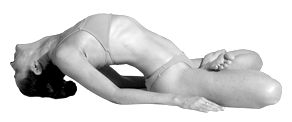Matsyasana
Matsyasana (Sanskrit: मत्स्यासन; IAST: Matsyāsana), or Fish Pose, is a backbend and asana in Hatha Yoga. It is commonly considered a counterasana to Sarvangasana (Shoulderstand), offering a stretch that normalizes the blood flow and stretches the muscles of the neck and shoulders after the intense flexion of Sarvangasana.
Etymology and origins[edit | edit source]
The name Matsyasana is derived from two Sanskrit words: Matsya meaning "fish" and Asana meaning "posture" or "seat". According to traditional texts, practicing this pose in water allows the yogi to float like a fish. The pose is mentioned in medieval Yoga texts like the Hatha Yoga Pradipika, suggesting its origins can be traced back to at least the 15th century.
Description[edit | edit source]
In Matsyasana, the practitioner lies on their back, lifts their heart towards the ceiling, and rests on their forearms with their head tilted back, opening the chest and throat. The legs can be extended straight, or for a more advanced variation, can be in Padmasana (Lotus Position). This pose is known for its ability to stretch the deep hip flexors, the muscles between the ribs, the muscles of the belly, the front of the neck, and the throat.
Health benefits[edit | edit source]
Matsyasana is credited with numerous health benefits, including:
- Relief from tension in the neck and shoulders
- Stimulation of the organs in the belly and throat
- Improvement in posture
- Relief from respiratory ailments by encouraging deep breathing
- Enhanced flexibility in the spine and hips
Contraindications[edit | edit source]
Individuals suffering from high or low blood pressure, migraines, or serious lower-back or neck injuries should avoid practicing Matsyasana. As with any yoga practice, it is recommended to perform under the guidance of a qualified instructor, especially for beginners or those with health concerns.
Variations[edit | edit source]
Several variations of Matsyasana exist to accommodate different levels of flexibility and experience:
- Supported Matsyasana, using a yoga block or bolster under the back for a gentler version
- Advanced Matsyasana, with legs in Padmasana
- Matsyasana with legs extended straight for beginners or those with less flexibility in the hips
In popular culture[edit | edit source]
Matsyasana has been featured in various yoga and fitness publications, highlighting its benefits for stress relief, flexibility, and strength. It is a staple pose in many yoga practices, from traditional Hatha Yoga to modern Vinyasa flows.
See also[edit | edit source]
This article is a Yoga-related stub. You can help WikiMD by expanding it!
Search WikiMD
Ad.Tired of being Overweight? Try W8MD's NYC physician weight loss.
Semaglutide (Ozempic / Wegovy and Tirzepatide (Mounjaro / Zepbound) available. Call 718 946 5500.
Advertise on WikiMD
|
WikiMD's Wellness Encyclopedia |
| Let Food Be Thy Medicine Medicine Thy Food - Hippocrates |
Translate this page: - East Asian
中文,
日本,
한국어,
South Asian
हिन्दी,
தமிழ்,
తెలుగు,
Urdu,
ಕನ್ನಡ,
Southeast Asian
Indonesian,
Vietnamese,
Thai,
မြန်မာဘာသာ,
বাংলা
European
español,
Deutsch,
français,
Greek,
português do Brasil,
polski,
română,
русский,
Nederlands,
norsk,
svenska,
suomi,
Italian
Middle Eastern & African
عربى,
Turkish,
Persian,
Hebrew,
Afrikaans,
isiZulu,
Kiswahili,
Other
Bulgarian,
Hungarian,
Czech,
Swedish,
മലയാളം,
मराठी,
ਪੰਜਾਬੀ,
ગુજરાતી,
Portuguese,
Ukrainian
Medical Disclaimer: WikiMD is not a substitute for professional medical advice. The information on WikiMD is provided as an information resource only, may be incorrect, outdated or misleading, and is not to be used or relied on for any diagnostic or treatment purposes. Please consult your health care provider before making any healthcare decisions or for guidance about a specific medical condition. WikiMD expressly disclaims responsibility, and shall have no liability, for any damages, loss, injury, or liability whatsoever suffered as a result of your reliance on the information contained in this site. By visiting this site you agree to the foregoing terms and conditions, which may from time to time be changed or supplemented by WikiMD. If you do not agree to the foregoing terms and conditions, you should not enter or use this site. See full disclaimer.
Credits:Most images are courtesy of Wikimedia commons, and templates, categories Wikipedia, licensed under CC BY SA or similar.
Contributors: Prab R. Tumpati, MD

